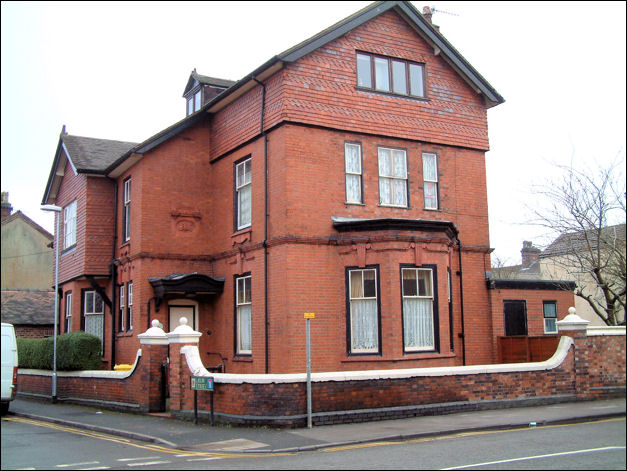Steve Ball is the inheritor of Malkin’s Folly, a belittling nickname given
to Burslem’s 1910 town hall, notable in modern times as the theatre where
Robbie Williams made his debut.
Steve tells me it is currently the home of the Queens Theatre Production
Society of which he is the chairman.
“We’re a non-profit company that gives entertainment performances for
community and family participation. The building belongs to the City but
my company maintains it through strong local connections. I honestly
think that’s what Sydney Malkin intended when he conceived the idea of
Burslem’s second town hall. To me Malkin was a showman and the Queens
Hall was his arena. He generated this fantastic dream of Burslem
becoming the City’s civic and entertainment centre. And although his
town hall proved to be a political letdown I reckon the Queen’s Theatre
is still Burslem’s greatest asset.”
|
The pottery manufacturer Sydney Malkin came to political distinction
long after Burslem was granted its own council in 1878.

Malkin's home - Waterloo Road,
Cobridge
“Sydney was the son of James Malkin who married the daughter of
Joseph Edge, a prominent industrialist with fingers in many pies of
Burslem governance,” explains Potteries’ historian Steve Birks.
“Whether as a board member of the first gasworks, a shareholder of
the infant tram company or a committee member of the Wedgwood
Memorial Institute, Joseph Edge was at the forefront. Following his
grandfather Sydney became a councillor in 1900 and served as
Burslem’s mayor in 1907.”
Malkin showed his rebellious nature at the beginning of the 20th
century when all the talk was of Federation. The Sentinel was full of
it and Arnold Bennett wrote about its implications in his novel The
Old Wives’ Tale published shortly before the event in 1910.
“Malkin was an advocate of Federation which was hostile to the
majority of his fellow councillors and civic leaders,” Steve
continues.
“Certainly the ‘big four’ authorities, Hanley, Stoke Burslem and
Longton had set up Federation committees and Malkin had a seat on
the Burslem group. But they couldn’t agree over incorporation and
the sharing of the various towns’ assets. For instance Burslem had
its own gas and fledgling electricity boards supplying Tunstall as
well. It managed its own sewerage disposal and water purification
plant, its hospital and public transport system. These were services
that had been built up in the heat of Victorian competitiveness, a
period that saw Hanley emerging as the principal retail centre.
Arnold Bennett noted this when he compared his Bursley of 1910 with
how it had been 30 years earlier.
‘It had all moved to arrogant and
pushing Hanbridge, with its electric light and its theatres and its
big advertising shops.’
Naturally Burslem’s leaders were worried
that after federation trade in Burslem would deteriorate even
further. But Malkin saw it differently. He saw the opportunity for
Burslem to become the civic centre if only it had the right
infrastructure. And that meant exciting buildings.”
|
It was Malkin who instilled and promoted the audacious idea that Burslem
would be the vibrant heart of the new federated borough. And so he hastily
commissioned plans to build a new council house opposite the existing town
hall. Naturally it met with strong opposition from Burslem’s over-cautious
aldermen, powerful leaders like president of the chamber of commerce
Warwick Savage. Nevertheless Malkin had his way.
“There little doubt Malkin hijacked the situation,” says Steve. “A poll
in Burslem in 1903 had resulted in a massive six-to-one against
federation. But 4 years on in 1907, as a result of Malkin’s’s
campaigning, a referendum in Burslem narrowed the gap with 2,074 now
voting for federation and 3,240 against.
And yet the rallying cry of the anti-federationists ‘To Die Fighting!’
remained the loudest.”
Despite this Malkin continued with his grand folly and the new town hall
and Queens Theatre was built on wasteland once occupied by an old wooden
theatre popularised by Arnold Bennett as the Blood Tub. The foundation
stone was laid in March 1910, just 14 days before the new federated
borough came into operation.
“It was an amazing and laughable situation because
Fred Geen was miles ahead
with his improvements at Stoke developing his new council chamber and
the spectacular Kings Hall,” says Steve. “But even at this late stage
Malkin must have assumed there was still a chance for Burslem.
In fact the first council meetings were held at the North Stafford Hotel
until it was finally decided that Stoke would be the new civic centre.
And yet it was Malkin’s folly that at least gave Burslem a brand new
theatre that seated 2000 including the smaller Princes Hall.”
The building hosted the magistrate’s courts and a number of conference
rooms. And throughout the rest of the century the Queens Hall remained in
popular public use with dances and theatrical productions.
“The auditorium is a fantastic space,” concludes Steve Ball. “It remains
an integral part of Burslem’s regeneration plans. But the town’s
infrastructure needs attention first. If regeneration is accomplished then
the Mother Town will have a regional attraction and be rid of the name
Malkin’s Folly for good.”

Malkin's Folly - Queen's Hall, Burslem
The foundation stone was laid in March 1910, just 14 days before the new
federated borough came into operation.
photo: Feb 2001
 more on Sydney Malkin
more on Sydney Malkin
 see the battle for the federation town hall
see the battle for the federation town hall

click the "contents"
button to get back to the main index
